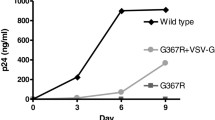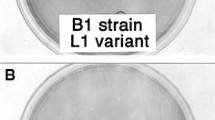Summary
Three cell clones producing large numbers of infectious or noninfectious particles of human immunodeficiency virus type 1 (HIV-1), designated M 10/LAV-2, M 16/LAV-3, and MT/LAV-17, were isolated from persistently HIV-1-infected MT-4 cells. In M 10/LAV-2, the HIV-1 proteins were defective in the cleavage ofgag precursor protein, and the particles were doughnutshaped with a double-ring structure. These particles were produced by budding at the cell surface from crescentic structures followed by the formation of double-ring structures. The viral proteins in M 16/LAV-3 were defective in the cleavage ofenv precursor protein. The morphology of the virus particles was intact, and an electron dense bar-shaped core was seen inside a single-ring enveloped structure. The intact particles were released from the cell surface by a budding process in which crescent shape structures first appeared at the cell membrane, then subsequently just before release matured to a complete structure with an electron dense core. In MT/LAV-17, the synthesis of HIV-1 proteins was normal, and the particles were teardrop-shaped with an intact core structure. These particles were produced by budding with an electron dense core at the cell surface.
Thus, it was suggested that the morphological maturation of HIV-1 particles was completed just before release from the cell surface in several cell clones producing HIV-1 particles of different morphology.
Similar content being viewed by others
References
Barré-Sinoussi F, Chermann JC, Rey F, Nugeyre MT, Chamaret S, Gruest J, Dauguet C, Axler-Blin C, Vézinet-Brun F, Rouzioux C, Rozenbaum W, Montagnier L (1983) Isolation of a T-lymphotropic retrovirus from a patient at risk for acquired immune deficiency syndrome (AIDS). Science 220: 868–871
Dalgleish AG, Beverley PCL, Clapham PR, Crawford DH, Greaves MF, Weiss RA (1984) The CD4 (T4) antigen is an essential component of the receptor for the AIDS retrovirus. Nature 312: 763–767
Fitting T, Kabat D (1982) Evidence for a glycoprotein “signal” involved in transport between subcellular organelles. Two membrane glycoproteins encoded by murine leukemia virus reach the cell surface at different rates. J Biol Chem 257: 14011–14017
Gazdar AF, Phillips LA, Sarma PS, Peebles PT, Chopra HC (1971) Presence of sarcoma genome in a “non-infectious” mammalian virus. Nature [New Biol] 234: 69–72
Gelderblom HR, Hausmann EHS, Özel M, Pauli G, Koch MA (1987) Fine structure of human immunodeficiency virus (HIV) and immunolocalization of structural proteins. Virology 156: 171–176
Goto T, Harada S, Yamamoto N, Nakai M (1988) Entry of human immunodeficiency virus (HIV) into MT-2, human T cell leukemia virus carrier cell line. Arch Virol 102: 29–38
Gumbiner B, Kelly RB (1982) Two distinct intracellular pathways transport secretory and membrane glycoproteins to the surface of pituitary tumor cells. Cell 28: 51–59
Harada S, Koyanagi Y, Yamamoto N (1985) Infection of HTLV-III/LAV in HTLV-I-carrying cells MT-2 and MT-4 and application in a plaque assay. Science 229: 563–566
Henderson LE, Sowder R, Copeland TD, Smythers G, Oroszlan S (1984) Quantitative separation of murine leukemia virus proteins by reversed-phase high-pressure liquid chromatography reveals newly describedgag andenv cleavage products. J Virol 52: 492–500
Hoxie JA, Alpers JD, Rackowski JL, Huebner K, Haggarty BS, Cedarbaum AJ, Read JC (1986) Alterations in T4(CD4) protein and mRNA synthesis in cells infected with HIV. Science 234: 1123–1127
Ikuta K, Coward J, Luftig RB (1986) The effect cerulenin on the synthesis of the precursorgag polyprotein in defective murine leukemia and sarcoma virus producing cell lines. Virology 154: 207–213
Ikuta K, Imai H, Ueda S, Suehiro S, Yamamoto N, Kato S (1987) Amplification of human immunodeficiency virus production from a virus-producing cell line in culture at high cell density. Jpn J Cancer Res (Gann) 78: 643–647
Ikuta K, Morita C, Miyake S, Ito T, Okabayashi M, Sano K, Nakai M, Hirai K, Kato S (1989) Expression of human immunodeficiency virus type 1 (HIV-1)gag antigens on the surface of a cell line persistently infected with HIV-1 that highly expressed HIV-1 antigens. Virology 170: 408–417
Ikuta K, Morita C, Nakai M, Yamamoto N, Kato S (1988) Defective human immunodeficiency virus (HIV) particles produced by cloned cells of HTLV-I-carrying MT-4 cells persistently infected with HIV. Jpn J Cancer Res (Gann) 79: 418–423
Katoh I, Yoshinaka Y, Rein A, Shibuya M, Odaka T, Oroszlan S (1985) Murine leukemia virus maturation: protease region required for conversion from “immature” to “mature” core form and for virus infectivity. Virology 145: 280–292
Katsumoto T, Hattori N, Kurimura T (1987) Maturation of human immunodeficiency virus, strain LAV, in vitro. Intervirology 27: 148–153
Katsumoto T, Hattori N, Yamada O, Kurimura T (1988) Intermediate virions in maturation of human immunodeficiency virus, strain LAV. J Electron Microsc 37: 205–207
Klatzmann D, Barré-Sinoussi F, Nugeyre MT, Dauguet C, Vilmer E, Griscelli C, Brun-Vezinet F, Rouzioux C, Gluckman JC, Chermann JC, Montagnier L (1984) Selective tropism of lymphadenopathy associated virus (LAV) for helper-inducer T lymphocytes. Science 225: 59–63
Klatzmann D, Champagne E, Chamaret S, Gruest J, Guetard D, Hercend T, Gluckman JC, Montagnier L (1984) T-lymphocyte T4 molecule behaves as the receptor for human retrovirus LAV. Nature 312: 767–768
Koyanagi Y, Harada S, Yamamoto N (1985) Correlation between high susceptibility to AIDS virus and surface expression of OKT-4 antigen in HTLV-I-positive cell lines. Jpn J Cancer Res (Gann) 76: 799–802
Laemmli UK (1970) Cleavage of structural proteins during the assembly of the head of bacteriophage T4. Nature 227: 680–685
Lee NH, Sano K, Morales FE, Imagawa DT (1987) Sensitive reverse transcriptase assay to detect and quantitate human immunodeficiency virus. J Clin Microbiol 25: 1717–1721
Lifson JD, Reyes GR, McGrath MS, Stein BS, Engleman EG (1986) AIDS retrovirus induced cytopathology: giant cell formation and involvement of CD 4 antigen. Science 232: 1123–1127
Lu AH, Soong MM, Wong PKY (1979) Maturation of Moloney murine leukemia virus. Virology 93: 269–274
Luftig RB, Yoshinaka Y (1978) Rauscher leukemia virus populations enriched for “immature” virions contain increased amounts of P70, thegag gene product. J Virol 25: 416–421
Maddon PJ, Dalgleish AG, McDougal JS, Clapham PR, Weiss RA, Axel R (1986) The T4 gene encodes the AIDS virus receptor and is expressed in the immune system and the brain. Cell 47: 333–348
McDougal JS, Kennedy MS, Sligh JM, Cort SP, Mawle A, Nicholson JKA (1986) Binding of HTLV-III/LAV to T4+ T cells by a complex of the 110K viral protein and the T4 molecule. Science 231: 382–385
McDougal JS, Nicholson JKA, Cross GD, Cort SP, Kennedy MS, Mawle AC (1986) Binding of the human retrovirus HTLV-III/LAV/ARV/HIV to the CD4 (T4) molecule: conformation dependence, epitope mapping, antibody inhibition, and potential for idiotypic mimicry. J Immunol 137: 2937–2944
Minowada J, Ohnuma T, Moore GE (1972) Rosette-forming human lymphoid cell lines. I. Establishment and evidence for origin of thymus-derived lymphocytes. J Natl Cancer Inst 49: 891–895
Miyoshi I, Taguchi H, Kubonishi I, Yoshimoto S, Ohtsuki Y, Shiraishi Y, Agaki T (1982) Type C virus-producing cell lines derived from adult T cell leukemia. In: Hanaoka M, Takatsuki K, Shimoyama M (ed) Adult T cell leukemia and related diseases. Japan Scientific Societies Press, Tokyo, Plenum Press, New York (GANN Monograph on cancer research, no 28, pp 219–228)
Nakai M, Imura S, Goto T, Imagawa DT, Sano K (1986) Ultrastructural features of AIDS virus morphogenesis. J Electron Microsc 35 [Suppl]: 3445–3446
Nakashima H, Koyanagi Y, Harada S, Yamamoto N (1986) Effect of HTLV-III on the macromolecular synthesis of HTLV-I carrying cell line, MT-4. Med Microbiol Immunol 175: 325–334
Palmer E, Sporborg C, Harrison A, Martin ML, Feorino P (1985) Morphology and immunoelectron microscopy of AIDS virus. Arch Virol 85: 189–196
Pinter A, de Harven E (1979) Protein composition of a defective murine sarcoma virus particle possessing the enveloped type-A morphology. Virology 99: 103–110
Popovic M, Read-Connole E, Gallo RC (1984) T4 positive human neoplastic cell lines susceptible to and permissive for HTLV-III. Lancet ii: 1472–1473
Popovic M, Sarngadharan MG, Read E, Gallo RC (1984) Detection, isolation, and continuous production of cytopathic retroviruses (HTLV-III) from patients with AIDS and pre-AIDS. Science 224: 497–500
Sarkar NH, Nowinski RC, Moore DH (1971) Helical nucleocapsid structure of the oncogenic ribonucleic acid viruses (oncornaviruses). J Virol 8: 564–572
Simionescu N, Simionescu M (1976) Galloylglucoses of low molecular weight as mordant in electron microscopy I. Procedure, and evidence for mordanting effect. J Cell Biol 70: 608–621
Towbin H, Staehelin T, Gordon J (1979) Electrophoretic transfer of proteins from polyacrylamide gels to nitrocellulose sheets: procedure and some applications. Proc Natl Acad Sci USA 76: 4350–4354
Yoshinaka Y, Luftig RB (1977) Murine leukemia virus morphogenesis: Cleavage of P70 in vitro can be accompanied by a shift from a concentrically coiled internal strand (“immature”) to a collapsed (“mature”) form of the virus core. Proc Natl Acad Sci USA 74: 3446–3450
Yoshinaka Y, Luftig RB (1977) Properties of a P70 proteolytic factor of murine leukemia viruses. Cell 12: 709–719
Yoshinaka Y, Luftig RB (1978) Morphological conversion of “immature” Rauscher leukaemia virus cores to a “mature” form after addition of the P65–70 (gag gene product) proteolytic factor. J Gen Virol 40: 151–160
Yoshinaka Y, Luftig RB (1982) p 65 of Gazdar murine sarcoma viruses contains antigenic determinants from all four of the murine leukemia virus (MuLV)gag polypeptides (p 15, p 12, p 30, and p 10) and can be cleaved in vitro by the MuLV proteolytic activity. Virology 118: 380–388
Zhang JJ, Goto T, Morita C, Nakai M, Ikuta K, Kato S (1988) Localization of the components of human immunodeficiency virus by immunocolloidal gold labeling. J Clin Electron Microsc 21: 625–626
Author information
Authors and Affiliations
Rights and permissions
About this article
Cite this article
Goto, T., Ikuta, K., Zhang, J.J. et al. The budding of defective human immunodeficiency virus type 1 (HIV-1) particles from cell clones persistently infected with HIV-1. Archives of Virology 111, 87–101 (1990). https://doi.org/10.1007/BF01310507
Received:
Accepted:
Issue Date:
DOI: https://doi.org/10.1007/BF01310507




